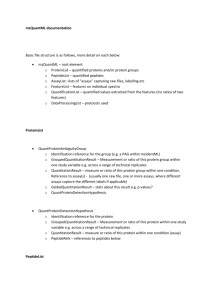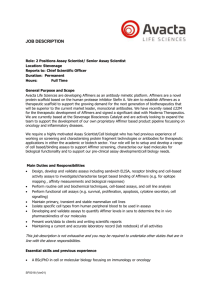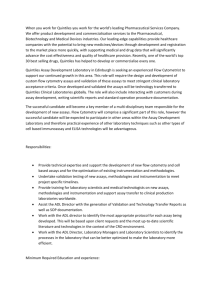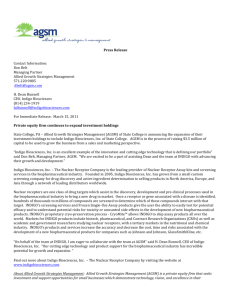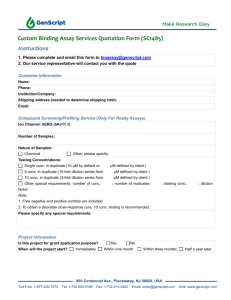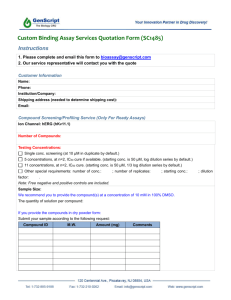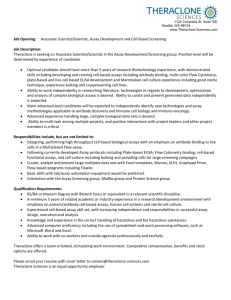INDIGO BioSciences' New Release
advertisement
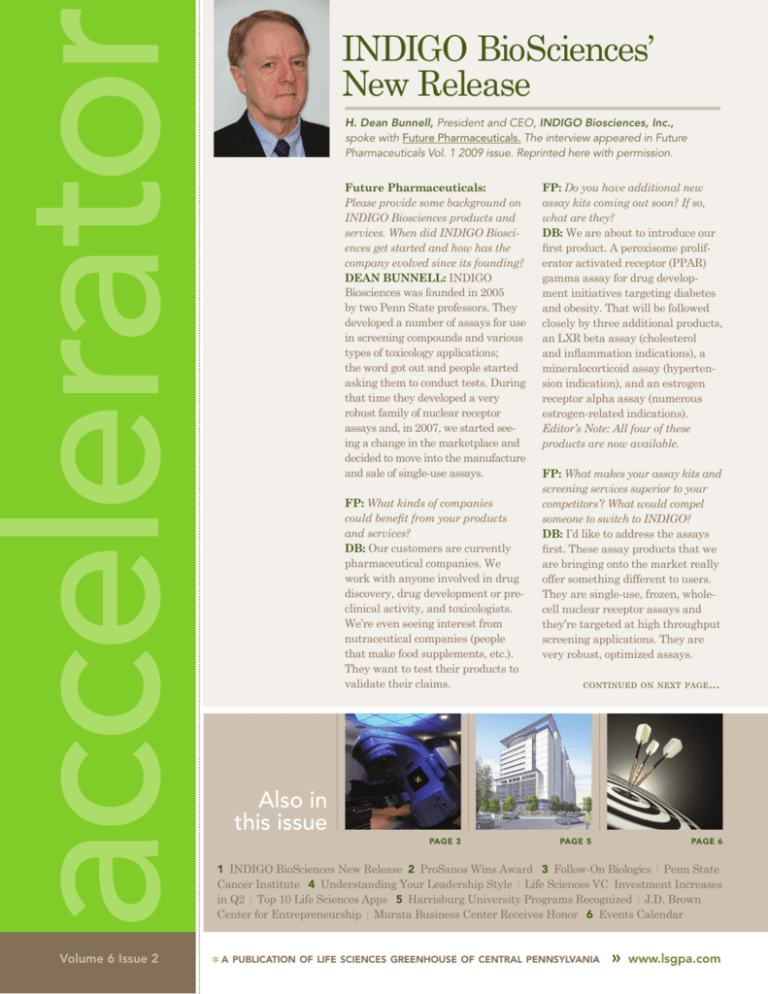
INDIGO BioSciences’ New Release H. Dean Bunnell, President and CEO, INDIGO Biosciences, Inc., spoke with Future Pharmaceuticals. The interview appeared in Future Pharmaceuticals Vol. 1 2009 issue. Reprinted here with permission. Future Pharmaceuticals: Please provide some background on INDIGO Biosciences products and services. When did INDIGO Biosciences get started and how has the company evolved since its founding? DEAN BUNNELL: INDIGO Biosciences was founded in 2005 by two Penn State professors. They developed a number of assays for use in screening compounds and various types of toxicology applications; the word got out and people started asking them to conduct tests. During that time they developed a very robust family of nuclear receptor assays and, in 2007, we started seeing a change in the marketplace and decided to move into the manufacture and sale of single-use assays. FP: What kinds of companies could benefit from your products and services? DB: Our customers are currently pharmaceutical companies. We work with anyone involved in drug discovery, drug development or preclinical activity, and toxicologists. We’re even seeing interest from nutraceutical companies (people that make food supplements, etc.). They want to test their products to validate their claims. Also in this issue page 3 FP: Do you have additional new assay kits coming out soon? If so, what are they? DB: We are about to introduce our first product. A peroxisome proliferator activated receptor (PPAR) gamma assay for drug development initiatives targeting diabetes and obesity. That will be followed closely by three additional products, an LXR beta assay (cholesterol and inflammation indications), a mineralocorticoid assay (hypertension indication), and an estrogen receptor alpha assay (numerous estrogen-related indications). Editor’s Note: All four of these products are now available. FP: What makes your assay kits and screening services superior to your competitors’? What would compel someone to switch to INDIGO? DB: I’d like to address the assays first. These assay products that we are bringing onto the market really offer something different to users. They are single-use, frozen, wholecell nuclear receptor assays and they’re targeted at high throughput screening applications. They are very robust, optimized assays. continued on next page … page 5 page 6 1 INDIGO BioSciences New Release 2 ProSanos Wins Award 3 Follow-On Biologics | Penn State Cancer Institute 4 Understanding Your Leadership Style | Life Sciences VC Investment Increases in Q2 | Top 10 Life Sciences Apps 5 Harrisburg University Programs Recognized | J.D. Brown Center for Entrepreneurship | Murata Business Center Receives Honor 6 Events Calendar Volume 6 Issue 2 [ a publication of life sciences greenhouse of central pennsylvania » www.lsgpa.com continued from front page … To look at the bottom line: these assays will save people time, money and reduce risks associated with their discovery and development programs. On top of that, we’ve designed these products to be as easy as possible to use so that anyone in the laboratory environment can simply take one of these frozen assays out of the freezer, thaw it, feed it, dose it, read it, then dispose of it. FP: You mentioned you have changed your business model to the manufacture and sale of single-use assays vs. screening. Can you tell us more about what led to that decision? DB: We saw a problem with people wanting us to test drugs that they didn’t feel comfortable sending outside their companies because of the possibility of compromising their Intellectual Property. The technical innovation that allowed us to contemplate transitioning from being strictly a service provider to being primarily a product provider was our development of a proprietary cryo-preservation process that we have trademarked as CryoMite. This process allows us to freeze live cells and bring them back extremely robust with a survivability rate of 95 percent and above. At the same time, we noticed a time and cost pressure on pharmaceutical companies for keeping their pipelines full and a stronger move into high throughput screening. In other words, people want to screen more, faster. It just seemed like a good fit that we could supply a product that would allow people to screen quickly with minimal involvement and cut their costs by not having to maintain live cell cultures in-house. In the screening environment, most pharmaceutical companies are hesitant to release test compounds outside of the company because of the risk of compromising their Intellectual Property. So the business in that area is very limited and we saw a greater opportunity by making a product that—instead of having to send test compounds to INDIGO—could send frozen assays to companies with drugs that they wanted to test where there’s IP associated with the compound or molecule. FP: Tell me about your management team: Who are they? And what are their roles in the company? DB: Dr. Jack Vanden Heuvel, our Chief Scientific Officer and Co founder, is a well-known toxicologist. He has over 15 years of experience in toxicological analysis, analytical processes and assay design. He’s been a major factor in bringing this family of assays forward over time. Dr. Bruce Sherf, our Chief Technical Officer, joined INDIGO in mid 2008. He brings 16 years of molecular biology experience and assay design, development and manufacturing. He has been a major force in bringing our frozen assays to the point where we’re ready to introduce them into the market. FP: What does INDIGO’s management team see as the biggest challenge facing your company? DB: I think what we’re looking at, forward speaking, is keeping up with customer demand and the acceleration of the production of new assays as we move forward. I think those will be our two biggest challenges. FP: As an early-stage biosciences company, you’ve created a great market opportunity with a unique research tool that seems to be ideal for pharmaceutical researchers. Is there room for new investors? And if so, what kinds of investors are you looking for? DB: There’s always room for new investors; INDIGO is looking for equity investors, particularly angel investors and early stage venture capitalists. FP: I heard you recently completed a beta testing, would you like to speak to the results? DB: Sure, we’ve just completed an extensive beta test on these products prior to releasing in the marketplace. The response was very positive. All of the feedback we’ve received has been extremely supportive and people are eager for us to begin to sell our products into the marketplace. H. Dean Bunnell, President and CEO of INDIGO Biosciences, Inc., has thrived for nearly 35 years leading successful startups and large multinational companies in various industries including biosciences, Internet, telecommunications, RF and microwave technologies and software analysis tools. His experience includes Kaman Industries, Locus Inc., Mitsubishi, California Eastern Labs & NEC Corporation, Aercom Industries, Litton Industries, MAXTECH, Inc. and Vertex Communications. At INDIGO Biosciences, Mr. Bunnell is transitioning the company’s business model in order to become a premiere global developer and producer of unique, frozen, single-use whole-cell nuclear receptor assay products for use in drug discovery, drug development and preclinical activities. Source: Future Pharmaceuticals, Vol. 1 2009. www.FuturePharmaUS.com [ ProSanos Recognized CEO of ProSanos Corp., Jonathan Morris, MD, pictured at the ProSanos booth at June’s DIA conference. Jon has good reason to smile after learning that ProSanos’ joint project with GlaxoSmithKline, SAEfety Works ®, was named by Bio-IT-World as one of the ten 2009 Best Practices Awards Winners. Congratulations! page 2 [ life sciences greenhouse of central pennsylvania » www.lsgpa.com Follow-On Biologics: A Primer T o grasp the notion of a follow-on biologic, one must first understand the difference between a “regular” drug and a biologic. The vast majority of prescription drugs are manufactured through chemical synthesis, meaning that they’re made by combining specific chemicals, usually resulting in what’s considered a “small molecule” active ingredient. In comparison, biologics, which include most vaccines and many recent breakthrough therapies (e.g., Erythropoietin), are “manufactured” in a living organism– like yeast or bacteria. This process often has many steps and usually results in a “large molecule” active ingredient. As the name implies, large molecules are very complex and can be much more difficult to characterize scientifically; some of the components of a finished biologic may actually be unknown. Consequently, biologic manufacturers can only guarantee product consistency and quality by ensuring that the manufacturing process always remains substantially the same. By contrast, chemical drug manufacturers can use varying manufacturing processes to achieve the same end results. These results can be easily confirmed through laboratory analysis of the finished product. The ability to confirm, with relative ease, the fact that one small molecule is substantially the same as another paves the way for generics. A generic drug by definition is any drug product whose patent life has expired and can be copied from the originator with permission from the Food & Drug Administration (FDA). Generic drugs must have the same active ingredient, strength, dosage form, and route of administration as the “original” drug, and act the same way in the body. Follow-on biologics (a.k.a., biosimilars) can best be described as large molecule generics manufactured in living organisms. So far the FDA has been reluctant to approve follow-on biologics. There are two key reasons: 1) some regulators are concerned that their safety and efficacy are not as easily assured as with generics; and 2) it’s not clear that the intellectual property law that governs production of small molecule chemical generics also applies to highly complex, large molecule followon biologics. The debate over whether or not to allow follow-on biologics and under what conditions began more than a decade ago, but may soon come to a head as lawmakers, scientists, biotechnology companies and other stakeholders grapple with how to balance the desire to expand access to medicines with the need to protect patient safety and promote further biomedical innovation. To learn more about this topic, visit: www.bio.org www.lifescienceleader.com Penn State Cancer Institute The Penn State Hershey Cancer Institute opened in July 2009 and is the first in the region to offer RapidArc radiotherapy technology, a new breakthrough in cancer treatment. The Institute’s new home is approximately 178,000 square feet. The building’s design creates an environment supportive of patients, families and staff. page 3 [ life sciences greenhouse of central pennsylvania » www.lsgpa.com Understanding Your Leadership Style (Part I of II) By: Juanita Neifert, LSGPA Project Manager/HR Specialist, with over 15 years human resource management experience. Webster’s defines leadership as: “the capacity to lead; the act of or an instance of leading; and/or the office or position of a leader.” Simply put, leadership is the art of motivating a group of people to act towards achieving a common goal. This is easier said than done. Why? Part of the issue with motivating a team is that they are made up of individuals with unique thoughts, ideas, personalities, and feelings. Everyone will not respond in the same way to the same request. Another problem might be your leadership style, or lack thereof. So how can you tell what kind of leader you are? Here are some of the most common styles for your review. [ Autocratic – In Autocratic leadership, a leader exerts high levels of power over his or her employees or team members. People within the team are given few opportunities for making suggestions. Many people resent being treated like this–who wouldn’t? Because of this, autocratic leadership often leads to high levels of absenteeism and staff turnover. [ Bureaucratic – Bureaucratic leaders work “by the book,” ensuring that their staff follow procedures exactly. This is an appropriate style if your work involves serious safety risks (such as working with machinery or toxic substances or at heights), or where large sums of money are involved. In most other situations, the inflexibility and high levels of control can not only demoralize staff, but can diminish the organization’s ability to react to changing external circumstances. [ Charismatic – The charismatic leader injects huge doses of enthusiasm into his or her team, and is very energetic in driving others forward. However, charismatic leaders tend to believe more in themselves than in their teams. In the eyes of the followers, success is tied up with the presence of the charismatic leader. [ Democratic or Participative – Although a democratic leader will make the final decision, he or she invites other members of the team to contribute to the decision-making process. This not only increases job satisfaction by involving team members in what’s going on, but it also helps to develop people’s skills. Life Sciences Venture Capital Investment Increases in Q2 2009: Up 47% Over Q1 Biotechnology Software Medical Devices & Equipment $1.46 bil. 1500 1200 $888 mil. 900 $576 mil. 600 0 While the transformational leadership approach is often a highly effective style to use in business, the reality is that there are many ways to lead. The challenge is to match your own style with the needs of the organization, the work involved and the skill levels and experience of the members of your team. And a good leader will find him or herself switching instinctively between styles according to the people and work they are dealing with. This is often referred to as “Situational Leadership.” In the next issue, “The Six Styles of Entrepreneurial Leadership.” $644 $628 mil. mil. 1Q 2009 2Q 2009 Year to Date Source: PricewaterhouseCoopers/National Venture Capital Association MoneyTree™Report, Data:Thomson Reuters Top 10 Life Sciences Related Apps for the iPhone and iPod Touch 10. 9. abTimer: A lab timer that allows for 4 sepaL rate timers with descriptions. (@iTunes.com) Measures – Unit Converter: a great help when working with odd units like the English system. (@iTunes) 8. 7. Primer Jot: A very simple way to keep your primers and oligos in order. (@iTunes) 6. Evernote for iPhone: Allows you to synchronize anything from notes, photos, snippets and even files. Great app for taking notes that you can later check on your computer, or viceversa. (@iTunes) 5. Solutions: For when you have trouble with your solubility calculations or just don’t want to keep running numbers through your calculator. (@iTunes) 4. Molecules: Lets you glimpse at molecules in 3D, allowing you to rotate them and zoom in to see their structure. (@iTunes) 3. iCut DNA: Allows quick access to the restriction enzyme database (REBASE) and detailed info on each restriction enzyme. (@iTunes) 2. 1. PubSearchPlus: Gives you full-text access to PubMed search. (@iTunes) [ Transformational – A person with this leadership style is a true leader who inspires his or her team with a shared vision for the future. Highly visible, they spend a lot of time communicating with their team. They don’t necessarily lead from the front, but rather tend to delegate responsibility amongst their teams. $452 mil. $1.08 bil. 300 [ Laissez-Faire – This French phrase means “leave it be” and is used to describe a leader who leaves his or her colleagues to get on with their work. It can be effective ONLY if the leader monitors what is being achieved AND communicates this back to his or her team regularly. $638 mil. $1.28 bil. The Chemical Touch: An intuitive Periodic Table app that also comes with an extra functionality that includes all the amino acids with detailed info, including chemical structure. (@iTunes) Promega: Allows you to check the protocols and applications guide as much as needed. (@iTunes) Source: http://my.biotechlife.net visit us online today for more news [ page 4 Guidebook Recommends Several Harrisburg University Programs The 26th edition of Rugg’s Recommendations on the Colleges lists six of the University’s undergraduate programs: Biotechnology, Computer and Information Sciences, Geography and Geospatial Imaging, Management & eBusiness, Chemistry, and Forensics. The recommendations in the 2009 issue are based on interviews with students, monthly evaluations from secondary school counselors, and responses to questions sent to more than 1,000 counselors. For more information, contact the University at 717.901.5146 or Connect@HarrisburgU.edu; or visit on the web at HarrisburgU.edu. J.D. Brown Center for Entrepreneurship The J.D. Brown Center for Entrepreneurship is an initiative of York College of Pennsylvania. Entering its fourth year, the Center has established itself as a hub for entrepreneurs who are looking to start businesses or grow their existing businesses. Center consultants are available to provide assistance with idea and new product validation, marketing plan development, prototype development assistance, and referrals to avenues of financing. Entrepreneurs are supported either directly or through referrals to SBDC, SCORE, SBA, the Ben Franklin Technology Partners initiatives and other strategic partners. The Center also features a Women Business Center Organization that supports women entrepreneurs via education on best practices in business. A new speaker series will begin this Fall, and will offer a series of timely topics. [ M urata Business Center Receives International Honor The National Business Incubation Association (NBIA) has awarded its Soft Landings International Incubator designation to the Murata Business Center in Carlisle. Through its Soft Landings program, NBIA recognizes incubators that have demonstrated the capability of helping nondomestic companies enter the incubator’s domestic market. Murata Business Center does just that. Accentuating its standard incubation services with assistance tailored specifically to nondomestic firms, the Center provides help with international trade issues, import and export laws, and visa/immigration requirements. Murata joins just 13 other business incubation programs from around the world that have earned the designation since NBIA began the program in 2005. This summer, the Center opened a business incubator to support the physical needs of entrepreneurs starting and growing their businesses. In addition to the services and connections described above, the tenants are supported by the Center through administrative personnel, internet access, telephone connectivity and meeting rooms. Center services and classes are available for review on their website at www.jdbctr.edu. Contact Michael March, Executive Director, directly at 717-815-6601, for more information. R&D Performed by Industry: Pennsylvania Ranks Ninth in U.S. F un d s e x p e n d e d b y P e nns y lva n i a bus i n e ss e s , 2 0 0 3 - 2 0 0 7 (Dollar Amounts Reflected in Millions) 2003 2004 2005 2006 2007 National Rank % change 2003-2007 Rank % change __________________________________________________________________________________________________________________ $709.1 $800.5 $884.6 $981.9 $1,038.7 9 46.5% 18% Source: SSTI.org/DigestTables page 5 [ life sciences greenhouse of central pennsylvania » www.lsgpa.com 225 Market Street | Suite 500 Harrisburg, PA 17101 If you are receiving this publication in error, or wish to be removed from our mailing list, please contact info@lsgpa.com. For information about funding opportunities and business support services provided by the Life Sciences Greenhouse of Central Pennsylvania, visit us online at www.lsgpa.com. Events Calendar october 16 november 17 November 16–17 Women on the Move Lancaster PA http://vc.hacc.edu Marketing for Small Businesses on a Budget York, PA www.yorkkiz.org BioTech2009 Philadelphia, PA www.biotech2009.org The Life Sciences Greenhouse is a public/private venture whose mission is to commercialize bioscience technologies. Clients include university-based researchers and technology development groups, emerging companies, and companies seeking to expand or relocate. LSGPA provides direct early-stage investment, targeted business development services, and connections to strategic partners. [ life sciences greenhouse of central pennsylvania H igh-Energy-Density Capacitors created by LSGPA portfolio company Strategic Polymer Sciences, Inc.
